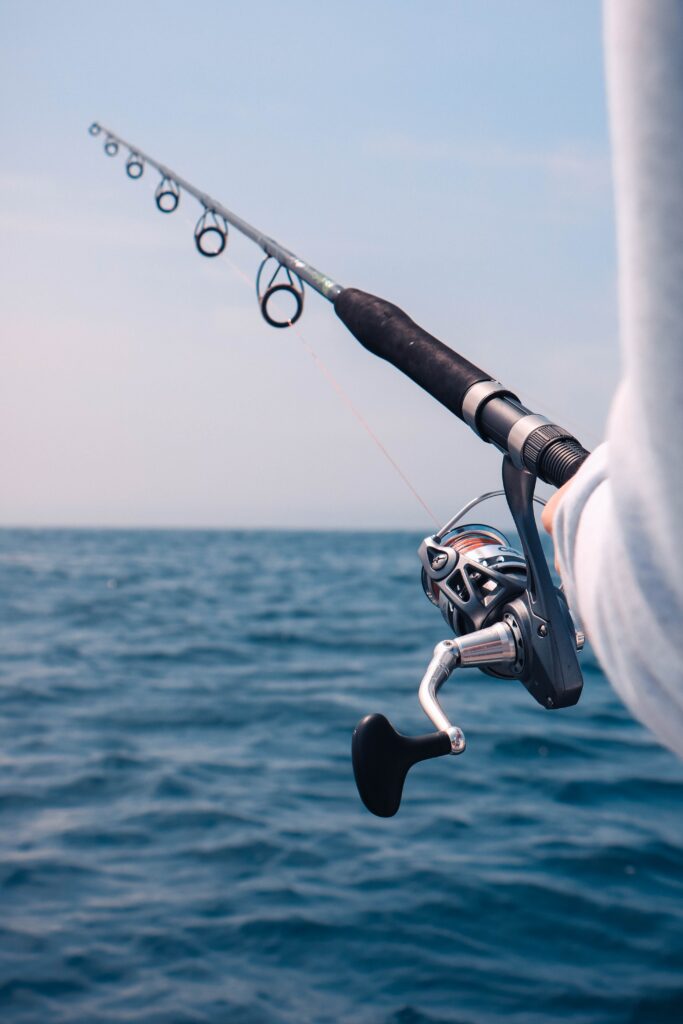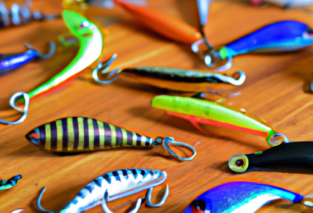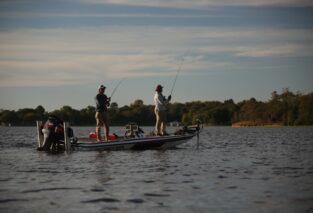Are you new to the world of fishing and feeling overwhelmed by all the different types of fishing gear out there? Look no further! “Tackling Fishing: An Introduction to Basic Tackle Setup” is here to help you navigate through the world of fishing tackle. Whether you are a beginner or just looking to refresh your knowledge, this article will guide you through the essential fishing gear you need to get started. From fishing rods and reels to hooks and lines, we’ve got you covered. Get ready to tackle fishing with confidence!

Choosing the Right Fishing Rod
When it comes to choosing the right fishing rod, it’s essential to understand the different types available. Each type of fishing rod is designed to perform optimally in specific fishing situations. The two main types of fishing rods are spinning rods and baitcasting rods.
Spinning rods are versatile and suitable for beginners and experienced anglers alike. They are easy to use, offering a smooth casting action and excellent line control. These rods are typically used for light to medium fishing, such as freshwater fishing for bass or trout. On the other hand, baitcasting rods are designed for more advanced anglers who need accuracy and control. They have a strong backbone, making them perfect for heavy fishing, such as deep-sea or offshore fishing.
Apart from the type of rod, you should also consider its length and power. The length of a fishing rod determines the casting distance and the amount of leverage you have when reeling in a fish. Longer rods are ideal for casting long distances, while shorter rods provide better accuracy in tight spaces. As for power, it refers to the rod’s strength and ability to handle heavy fish. Power ranges from ultra-light to heavy, with each category suitable for different fish species and fishing techniques.
Lastly, evaluating the material of the fishing rod is crucial. The two primary materials used in fishing rods are fiberglass and graphite. Fiberglass rods are more durable and flexible, making them resistant to breaking or snapping when under pressure. They are excellent choices for beginners or anglers who prefer more forgiving rods. On the other hand, graphite rods are lightweight and offer fantastic sensitivity, allowing you to feel even the slightest nibble on your line. They are perfect for experienced anglers who want a more responsive and powerful rod.
Selecting the Appropriate Fishing Reel
Once you have chosen the right fishing rod, it’s time to select the appropriate fishing reel. Fishing reels are essential for smoothly winding and controlling your fishing line. There are various types of fishing reels available, each with its advantages and suitable fishing applications.
Spinning reels, also known as open-faced reels, are the most popular and versatile choice for many anglers. They are easy to use, making them ideal for beginners. Spinning reels are designed to hang below the fishing rod, allowing for better line control and reducing line twist. They work well with a wide range of fishing techniques and can handle both light and heavy fishing situations.
Baitcasting reels, on the other hand, offer unparalleled accuracy and control. These reels have a unique design that allows the spool to rotate during casting, resulting in longer and more precise casts. Baitcasting reels are commonly used by experienced anglers who want to target larger and more challenging fish species. They require a bit more skill to operate effectively but can provide excellent results once you master the technique.
When choosing a fishing reel, it’s important to consider factors such as the size, gear ratio, and braking system. The size of the reel should match the fishing rod you intend to use, ensuring a balanced setup. The gear ratio determines how quickly the line is retrieved, with higher ratios ideal for fast-moving fish. Lastly, the braking system helps prevent backlash and allows for more accurate casting. Magnetic and centrifugal braking systems are commonly found in baitcasting reels.
Exploring Fishing Lines
Fishing lines are an integral part of your tackle setup and play a vital role in your fishing success. Understanding the different types of fishing lines and their characteristics will help you make an informed decision.
The three main types of fishing lines are monofilament, fluorocarbon, and braided lines. Monofilament lines are made of a single nylon filament and are known for their versatility. They are the most commonly used fishing lines and offer a good balance of strength, castability, and affordability. Monofilament lines are ideal for a wide range of fishing applications, from freshwater to saltwater fishing.
Fluorocarbon lines are relatively new but have gained popularity due to their excellent invisibility underwater. They are nearly invisible to fish, making them ideal for clear water and finicky fish species. Fluorocarbon lines also have a higher density than water, allowing them to sink quickly. However, be aware that they are more expensive than monofilament lines.
Braided lines are incredibly strong and durable, making them suitable for heavy fishing situations. They consist of multiple fibers woven together and have minimal stretch compared to monofilament and fluorocarbon lines. Braided lines have a small diameter and excellent sensitivity, allowing you to feel even the lightest bites. However, they are more visible in the water and may require a leader to prevent spooking fish.
When evaluating fishing lines, consider factors such as strength, durability, stretch, and visibility. The strength of the line should match the size of the fish you are targeting. Durability is essential, especially when fishing in areas with rocks or sharp objects that can easily cut the line. Stretch can affect sensitivity, with low stretch lines providing better feel and hook sets. Lastly, visibility may be a concern in clear water situations, so choose a line color that blends well with the surroundings.
Deciphering Fishing Hooks
Fishing hooks are one of the most critical elements of your tackle setup, as they are responsible for hooking and securing your catch. Understanding the anatomy of fishing hooks, as well as the factors to consider when choosing the right hooks, is essential for successful fishing.
Fishing hooks consist of several parts, including the shank, bend, point, eye, and barb. The shank is the straight part of the hook, while the bend is the curved portion. The point is the sharp end used to penetrate the fish’s mouth, and the eye is the loop where the fishing line is attached. Lastly, the barb is the small projection on the hook’s bend that prevents the fish from easily escaping.
Choosing the right size and shape of fishing hooks depends on the target fish species, bait used, and fishing technique. Hooks are available in various sizes, denoted by numbers, with larger numbers indicating smaller hooks. For example, a size 1 hook is smaller than a size 5 hook. The hook’s shape also determines its effectiveness in hooking and holding fish. Some popular hook shapes include J-hooks, circle hooks, and treble hooks, each with its specific uses.
Consider factors such as hook material and barb when choosing fishing hooks. Most hooks are made of either stainless steel or high-carbon steel, with stainless steel being more corrosion-resistant. Barbless hooks are ideal for catch-and-release fishing, as they cause less harm to the fish and are easier to remove. However, barbed hooks offer a higher hook-up rate, ensuring the fish stays hooked during the fight.

Sinkers, Bobbers, and Swivels
Sinkers, bobbers, and swivels are essential accessories that can enhance your fishing experience and increase your chances of catching fish.
Sinkers, also known as weights, are used to make your bait or lure sink to the desired depth. They come in various shapes and sizes, allowing you to adjust the sink rate and fishing technique. Common sinker types include split shot sinkers, bullet sinkers, and egg sinkers. Split shot sinkers are small and easily adjustable, making them perfect for finesse fishing. Bullet sinkers are streamlined and ideal for long-distance casting. Egg sinkers are versatile and suitable for a wide range of fishing applications.
Bobbers, also called floats, serve as visual indicators of fish bites. They are attached to the fishing line and float on the water’s surface, keeping the bait or lure suspended at a specific depth. Bobbers come in different shapes and sizes, with round and slip bobbers being the most common. Round bobbers are easy to use and ideal for beginners, while slip bobbers allow for more precise depth adjustments.
Swivels are small devices that provide line management and prevent line twist. They consist of two rings connected by a rotating center piece. Swivels are used to attach the mainline to the leader, allowing the bait or lure to move freely and preventing tangles. They are particularly useful when using lures that have a spinning action, as they prevent the fishing line from twisting.
Understanding the purpose and uses of sinkers, bobbers, and swivels will help you customize your tackle setup to suit your fishing preferences and conditions.
Fishing Lures and Baits
Fishing lures and baits are essential for attracting fish and enticing them to bite. Understanding the differences between lures and baits, as well as the various types available, will enhance your fishing success.
Lures are artificial imitations designed to mimic the appearance and movement of prey fish. They come in a wide range of shapes, sizes, and colors, each tailored for specific fishing situations. Some popular types of fishing lures include crankbaits, spinnerbaits, soft plastics, and topwater lures. Crankbaits are often used for bass fishing and have a diving lip that allows them to dive to a specific depth. Spinnerbaits have a rotating blade that creates vibrations and flash, attracting predatory fish. Soft plastics, such as worms and crawfish imitations, are versatile and can be used for a variety of fish species. Topwater lures are designed to imitate insects or small fish and are retrieved along the water’s surface, creating exciting strikes.
Baits, on the other hand, are natural food sources used to attract fish. They can be either live or dead and are typically used with fishing hooks. Live baits, such as worms, minnows, and crayfish, are highly effective in enticing fish due to their natural scent and movement. Dead baits, such as cut bait or prepared dough baits, also attract fish but may require additional attractants to enhance their effectiveness.
When evaluating fishing lures and baits, consider factors such as the fish species you are targeting, water conditions, and fishing technique. Matching the lure or bait to the fish’s natural prey will increase your chances of triggering a strike. Additionally, select colors and sizes that mimic local baitfish or insects. Experimenting with different lures and baits is part of the fun of fishing, so don’t be afraid to try new techniques and see what works best for you.

Putting Together the Fishing Rig
A fishing rig refers to the complete setup of the fishing line, hooks, sinkers, and other components. Putting together the fishing rig correctly is crucial for ensuring a successful and hassle-free fishing experience.
Understanding the basic components of a fishing rig is the first step. The mainline is the fishing line directly attached to the reel, while the leader is a separate section of line attached to the mainline. The leader is often made of a different material, such as fluorocarbon, and serves as a more invisible and abrasion-resistant section for tying the fishing hook or lure. The terminal tackle includes all the small components at the end of the line, such as swivels, sinkers, bobbers, and hooks.
Assembling the terminal tackle correctly is important for various fishing techniques. For example, when using a Carolina rig for bottom fishing, you would attach a sinker to the mainline, followed by a swivel, and then tie the leader and fishing hook to the other end of the swivel. This setup allows the bait to float slightly off the bottom, enticing fish to strike. Different fishing techniques may require different configurations of the terminal tackle, so it’s crucial to understand the specific setup for each technique.
The final step in putting together a fishing rig is tying the knots to secure the tackle setup. There are various fishing knots, each with its specific uses and strengths. Some common knots include the improved clinch knot, Palomar knot, and uni knot. These knots ensure that the fishing line, hooks, and other components remain securely attached during casting and retrieval. Practice tying knots until you are confident in your skills, as a weak knot can lead to lost fish and frustration.
Basic Casting Techniques
Mastering basic casting techniques is crucial for effectively presenting your bait or lure and reaching your target fishing spots. Three common casting techniques to practice are the overhead cast, sidearm cast, and roll cast.
The overhead cast is the most commonly used casting technique and is suitable for various fishing situations. To execute an overhead cast, hold the fishing rod with both hands, with your dominant hand gripping the rod handle and your other hand supporting the rod above the reel. Bring the rod back over your shoulder, then swiftly bring it forward, releasing the line as you reach the desired point. Practice the timing and smoothness of your cast to achieve maximum distance and accuracy.
The sidearm cast is particularly useful when fishing in tight spaces or under low branches. Hold the fishing rod horizontally, with your dominant hand gripping the handle and your other hand providing support. Similar to the overhead cast, bring the rod back behind you, then swiftly bring it forward, releasing the line and aiming towards your target. The sidearm cast allows for better clearance when casting around obstacles and can be performed with less overhead clearance.
The roll cast is an excellent technique for fishing in tight spaces or when there is limited room for a backcast. Hold the fishing rod with your dominant hand, with your thumb on top of the rod handle. Use your wrist to flick the rod forward, applying gentle power to create a loop in the line. As the loop extends, move your arm forward to propel the line towards the target. The roll cast is particularly useful for fishing in small streams or when there is vegetation behind you.
Remember to practice these casting techniques regularly to improve your skills and increase your fishing success. Casting accuracy and distance will make a significant difference in your ability to present your bait or lure effectively.

Proper Maintenance of Tackle
To ensure your fishing tackle performs at its best and lasts for a long time, proper maintenance is essential. Regular cleaning and inspection of fishing rods, reels, lines, and hooks will prolong their lifespan and prevent any performance issues.
Cleaning fishing rods and reels is relatively simple and involves removing dirt, debris, and salt residue. Use a soft cloth or sponge to wipe down the rod and reel, paying attention to the guides and reel seat. Avoid using harsh chemicals or abrasive materials that can damage the rod or reel finish. Make sure to dry the equipment thoroughly before storing it to prevent corrosion.
Replacing damaged or worn-out fishing lines is crucial for maintaining optimal performance. Inspect the fishing line for any frays, abrasions, or weak spots. If you notice any signs of damage, replace the line immediately to prevent line breakage during a fishing trip. It’s also a good idea to replace old fishing lines periodically, even if they appear to be in good condition, as they can weaken over time.
Sharpening and replacing fishing hooks is another essential maintenance task. Dull hooks can result in missed strikes or lost fish. Use a hook sharpener to sharpen the point of the hook, ensuring it is razor-sharp. If a hook is heavily damaged or rusted, it’s best to replace it entirely. Regularly inspect your hooks for any signs of damage or rust, and replace them as needed.
By properly maintaining your fishing tackle, you can enjoy many seasons of successful fishing without any equipment failures or setbacks.
Safety Considerations for Fishing
While fishing is a fun and enjoyable activity, it’s important to prioritize safety to ensure a pleasant and accident-free experience. Here are some safety considerations to keep in mind when out on the water.
Wearing appropriate safety gear is essential to protect yourself from potential hazards. Always wear a properly fitting life jacket or personal flotation device, especially when fishing from a boat or in deep waters. Make sure the life jacket is approved by your local boating authority and is in good condition. Additionally, wearing a hat, sunglasses, and sunscreen will protect you from the sun’s harmful rays and minimize the risk of sunburn or heatstroke.
Adhering to fishing regulations and limits is not only important for sustainability but also for your safety. Familiarize yourself with local fishing regulations, including fishing seasons, size limits, bag limits, and catch-and-release guidelines. These regulations help maintain healthy fish populations and ensure a fair and sustainable fishing experience for all anglers.
Being aware of your surroundings and weather conditions is crucial for staying safe while fishing. Pay attention to changing weather patterns, such as wind, lightning, or approaching storms. If lightning is imminent, seek shelter immediately and avoid fishing near water bodies. Additionally, be cautious of slippery surfaces, uneven terrain, or hidden obstacles that may cause accidents.
By prioritizing safety and taking necessary precautions, you can enjoy a worry-free fishing experience and make lasting memories on the water.
In conclusion, choosing the right fishing tackle and understanding its various components are key to a successful and enjoyable fishing experience. Whether it’s selecting the right fishing rod and reel, choosing the appropriate fishing line, or deciphering the different types of hooks and sinkers, taking the time to educate yourself will greatly enhance your chances of catching fish. Additionally, mastering basic casting techniques, properly maintaining your tackle, and prioritizing safety considerations are essential for a safe and rewarding fishing adventure. So grab your tackle box, head to your favorite fishing spot, and enjoy the beauty and excitement of this timeless outdoor activity.






